|
Main results
2012
In 2012 several core-collapse supernovae and gamma-ray bursts were
observed with the 6-meter BTA and 1-meter Zeiss telescopes of SAO RAS
and some observational material under the program was obtained
with the Zeiss-2000 telescope (Terskol Branch of the Institute of Astronomy
of RAS).
Photometric and spectroscopic observations of the type IIp supernova SN 2009bw
Since there is a relation between some GRBs and core-collapse supernovae
a question arises why we do not observe signs of SNE in all GRBs and,
correspondingly, gamma-ray and X-ray emission is not detected in all SNe
(J. Hjorth & J. S. Bloom 2011, chapter 9 in "Gamma-Ray Bursts",
eds. C. Kouveliotou, R. A. M. J. Wijers, S. E. Woosley, Cambridge
University Press, arXiv:1104.2274). Programs aimed to the study of such
relations are fulfilled at BTA and other telescopes. Within the context of
such study both SNe related to GRBs or X-ray flares (SN 2006aj, SN 2008D)
and usual supernovae and GRBs are studied. In 2009 the type IIp supernova
SN 2009bw (MR = -17.82) was observed jointly with D.Tsvetkov (SAI MSU),
C. Inserra and S. Benetti (INAF, Italy). The supernova has shown the signs
typical both for normal and for bright events of this type. During the
photospheric phase the manifestation of elements of the CNO cycle were observed,
which happened only in several other events. Velocities of hyrogen lines
measured from data of spectral investigation (including those of BTA) remained
sufficiently high, which can be interpreted as interaction between a
supernova jet and matter surrounding a progenitor star. Similar
manifestations were also observed for SN 2006aj related to the
gamma-ray burst and X-ray flare GRB/XRF 060218.
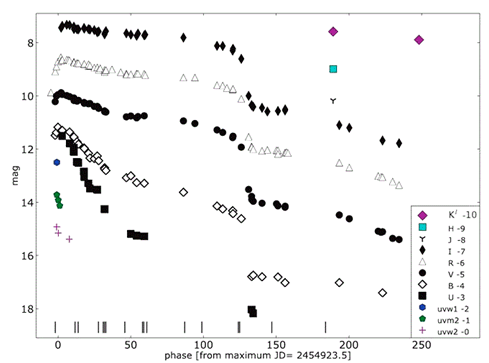
UV, optical and IR light curves of the supernova SN 2009bw.
Ones of the earliest photometric points were obtained with the 1-meter
SAO RAS telescope Zeiss-1000.
Modelling spectra of the type IIb supernova SN 2011fu
It is thought that type IIb supernovae explode from supergiants which
did not lose their hydrogen envelope completely (e.g. see Pastorello
et al. 2008, MNRAS, 389, 955). At early stages their spectra are equally
dominated by helium and by strong hydrogen lines which become weaker
afterwards. Besides, if assumptions about presence of hydrogen and
helium lines in spectra of supernovae related to GRBs and XRFs are
correct, then the observations of just type IIb supernovae are
extremely important for understanding the nature of GRB progenitors.
We fulfilled the detailed modelling of spectral lines of the supernova
SN 2011fu which was observed photometrically and spectroscopically with
many telescopes. Spectral observationes started in a week after
detection and ended in 4 months. Evolution of temperature and velocity
of expanding envelopes was traced. It was detected that continuum
can be described by the temperature 6500-6700 K at early stages and
~5000 Ê at late ones. Velocity of the pseudophotosphere (the layer
over which the spectral lines are basically formed) were falling from
14000 km/s at early stages to 5000 km/s at the latest ones. The
difference between velocities of the photospehre and hydrogen layer
reached several thousands
of km/s (velocity is proportional to distance from the center),
which was also observed in other cases (SN 2006aj, SN 2008D,
e.g. see Sonbas et al. 2008, Astrophys. Bulletin, 63, 244; Moskvitin
et al., 2010, Astrophys. Bulletin, 65, 139). The determined values
of the above parameters agree well with results obtained for other
supernovae of this type. (SN 1993J, SN 2003bg, SN 2008ax).
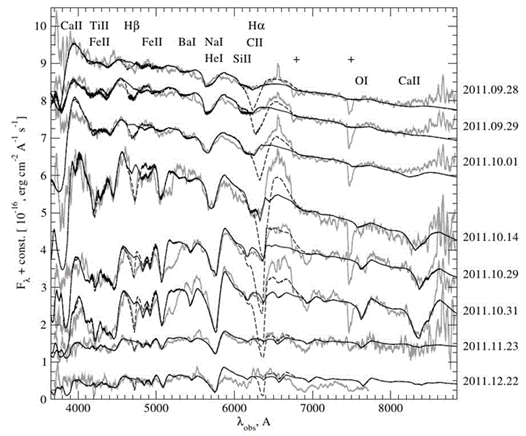
Spectral evolution of the supernova SN 2011fu (the gray line). Model
spectra obteined with the SYNOW code are shown by the black lines (the
solid line for H-alpha and the dashed one for H-beta)
2011
In 2011 several core-collapse supernovae and GRBs were observed with
the 6-meter BTA and 1-meter Zeiss-1000 telescopes of SAO RAS. The observational
material under our programs was also obtained with Zeiss-2000 and
Zeiss-600 (Terskol Branch of Institute of Astronomy of RAS) and two 32-meter
radio telescopes of Institute of Applied Astronomy of RAS).
Observations of GRB 110801A
Among all observed GRBs we can mark out especially the gamma-ray burst
GRB 110801A which became 3 st. magnitudes brighter within half an hour.
Its early spectrum was obtained, and later - a deep Rc-band image
where near the optical transient one can see an extended object which
may be the host galaxy. The object was observed in the r filter with GTC
and in BVRcIc with BTA.

The GRB 110801A field obtained with BTA+Scorpio on August 9.915, 2011 in
the Rc filter with the exposiure time 2100 sec. The FWHM seeing was
1".2. The area of the GRB110801A field was enlarged. Precision of
astrometric calibration was 0".7. It is noticeable that the objects looks
double.
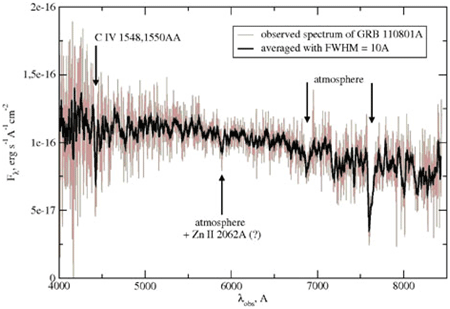
Spectrum of GRB110801A optical afterglow obtained with BTA+Scortio
~ 4.5 hours after the burst.
The peculiar supernova SN2008iy
SN 2008iy is one of the most interesting supernovae studied within the
scope of the project (Drake et al., ATel 1768, 2008; Mahabal et al., ATel 2010,
2009; Catelan et al., CBET 1780, 2009). Spectra obtained 5 months apart
changed very few. The question about the nature of this object arises:
is this a type IIn supernova of a quasar? In the light curve we observed
the record-long rise of duration of about a year, and after the maximum
a vary slow decrease (Miller et al., MNRAS, 404, 305, 2010). The active phase
of the burst has been lasting several years already. Detection of spectral
features typical for the nebular phase of a supernova would be crucial
for solution of the object nature. Now, when the object is rather faint,
it is possible to observe it only with large telescopes of the BTA class.
Spectral and photometrical data were obtained with the 6-meter telescope
of SAO RAS. The photometrical monitoring was also done with the telescope
Zeiss-1000. The final stage of observation will be spectroscopy or
wide-band photometry of the host galaxy of the object with the purpose
of modelling spectral energy distribution and the study of its properties.
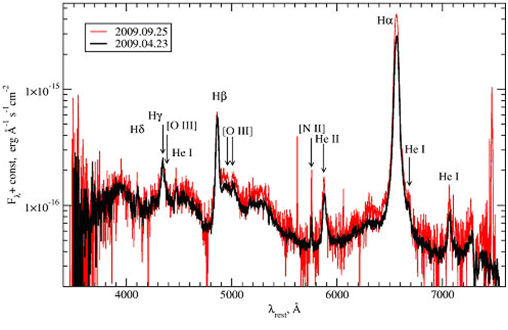
Spectra of SN 2008iy obtained with BTA+Scorpio on April 23 (the black line)
and September 25 (the gray line) 2009. The red shift of the object z=0.041
measured from BTA spectra agrees with data adduced in the paper by Miller et al.
The type Ic supernova SN 2009jf
We observed the late stage of the type Ic supernova SN 2009jf which is
studied together with the team of the indian institute ARIES (S. B. Pandey,
R. Roy, Brajesh Kumar, Brijesh Kumar). At the beginning of June we obtained
direct BTA images in BVRc filters and the spectrum covering the total
optical range. The practically total absence of signs of this nearby supernova
was noted. This allows us starting the study of that region of the galaxy
NGC 7479 where the explosion happened.
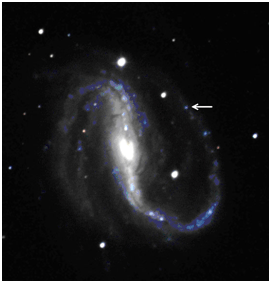
The type Ic supernova SN 2009jf in the nearby galaxy NGC 7479.
The colored image is composed from BVRs images (the Zeiss-1000 telescope
of SAO RAS, June 8, 2010).
2010
Nearby type II supernovae SN 2008gz è SN 2008in.
Spectral evolution of SN 2008gz and SN 2008in was traced in collaboration
with indian and italian participants of out international team.
B, V, R, I light curves have been obtained. The bolometric light
curve of SN 2008gz was compared with light curves of supernovae of
the identical type - SN 2004et è SN 1987A. The SN 2008gz explosion
energy turned out to be comparable with the energy of SN 2004et.
The lines had the PCyg profile in spectra close to maximum. They
were investigated with the multiparametric code SYNOW (D.Branch
et al., ApJ, 566, 1005 (2002)). The modelling showed that the
code limitations are strong for late spectra: the emission part of
hydrogen lines is described badly. To build the curves of SN 2008gz
envelopes and photosphere velocity decrease the absorption minimums
were measured. All details of the study of SN 2008gz are presented
in the paper by R.Roy et al.

SN 2008gz spectrum obtained on November 11, 2008, with the
telescope TNG+DOLORES (the thick gray line). The thin black line
shows the best fitting by the model spectra generated by the SYNOW code.
The cosmological peculiar type Ic supernova SN 2009de
SN 2009de was discovered in the CRTS survey and investigated
photometrically and spectroscopically at the telescopes of this survey
and at Palomar 60, Palomar 200, BTA, Zeiss-1000 and Keck I. The study of
such objects is important for cosmplogical tasks. To detect and study
spectral energy distribution of the host galaxy of this supernova,
the deep BTA imaging is planned for the nearest future. At the moment,
from results of observations with BTA and Zeiss-1000 it is known that
the galaxy luminosity R ~ 24.4. The KeckI noisy spectrum showed the
presence of emission lines H-beta, [OIII] 4958, 5006AA, H-alpha. This
means that it is possible to obtain high-quality photometrical BTA
data for modelling spectral energy distribution of the host galaxy.
The red shift estimation z=0.311 is close to the value determined
from the fitting of wide spectral details of the SN with the SNID code.
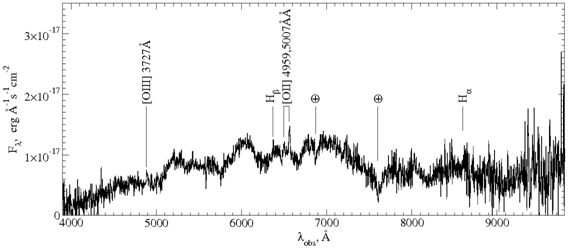
Identification of emission lines of the host galaxy in the BTA spectrum
of SN 2009de. The lines of [OII] 3727A, H-beta, [OIII] 4959, 5007AA were
identified. The signs of the H-alpha line were recently confirmed
by the KeckI spectrum of the host galaxy (A.Drake, private comm., 2010).
2009
Identification and early spectral observations of the optical transient of
GRB090726
Information on the gamma-ray burst GRB090726 was got in SAO from the space
platform SWIFT (the error area of radius 3’) at 22:42:27 UT on 26 July 2009.
The first images were obtained in BVRI bands of the Zeiss-1000 telescope of
SAO RAS half an hour after the burst (Fig.1). A fading object of st.magn.
18.26 in the R band was detected within the errors of coordinate determination
which was absent from DSS images. More precise coordinates received from the
X-ray telescope SWIFT/XRT coincided with our data. The spectrum of the optical
transient was obtained with the telescope BTA+SCORPIO in one and a half hour
after the burst (Fig.2).

Fig.1 Left: DSS image of the SWIFT/BAT error region (the R band). Right:
the direct image obtained with the SAO RAS telescope Zeiss-1000 half of hour
after the gamma-ray burst. The position of the optical transient of GRB090726
is marked

Spectrum of the GRB090726 optical transient with identified lines obtained
with BTA in half and an hour after the burst.
The first telegram (http://gcn.gsfc.nasa.gov/gcn3/9709.gcn3) confirming the
variable character of the detected optical source was published several hours
after the event. The second telegram with the results of interpretation of the
spectrum obtained with BTA was published during one day agter the burst. The
interpretation was fulfilled together with our Spanish colleagues within the
scope of the international program of the study of GRBs. Our spectrum allowed
us determining the red shift z = 2.71, identifying absorption lines of highly
ionized atoms and the Ly alpha line. The spectrum of the object with
coordinates R.A.(J2000.0)=16:34:43.044, DEC(J2000.0)=+72:53:04.82 was obtained
with BTA - the most northern large telescope.
T.Fatkhullin, A.Moskvitin, A.Valeev, S.Fabrika, O.Sholukhova, V.Sokolov in
collaboration with A.de Ugarte-Postigo (OAB-INAF, Italy), A.Castro-Tirado and
H.Gorosabel (IAA-CSIC, Spain).
Participation of SAO in the international monitoring of the most distant
gamma-ray burst with the red shift z = 8.26.
N.R. Tanvir, D.B. Fox, A. J. Levan, E. Berger, T.A.Fatkhullin, V.N.
Komarova, A.S.Moskvitin, et al. "A gamma-ray burst at a redshift of z ~
8.2" Nature, Vol. 461, 2009, p. 1254
Abstract. It is thought that gamma-ray bursts arise as a result of
explosion of certain core-collapse stars, and some of them are so bright that
the modern methods allows us observing them as far as up to red shifts z > 20.
Up to now the largest measured red shift was z=6.96 for a galaxy emitting in
Lyman-alpha. The paper informs that the gamma-ray burst GRB090423 is at the
distance z~8.2. This means that massive stars were coming into existence and
dying approximately 630 million years after the Big Bang. This gamma-ray burst
also indicates the precise position of its host galaxy.
Spectral and photometrical monitoring of distant supernovae
In the course of joint spectral and photometrical observation under the
international monitoring program the following supernovae were discovered: SN
2009bx, SN 2009cb, SN 2009db, SN 2009dy, SN 2009dw, SN 2009ew, SN 2009ji.
Their brightness, color, redshift.

Comparison of spectrum of the supernova SN2009db with the template spectrum
from the database SNID with the purpose to determine the object type and red
shift.
T.A.Fatkhullin, A.S.Moskvitin, A.F.Valeev, O.I.Spiridonova, V.v.Sokolov in
collaboration with R.Roy and Brajesh Kumar (ARIES, India) et al.
Study of spectral evolution of the supernova 2008gz
Within the scope of the international program, the spectral observation of
the supernova 2008gz were performed to study its spectral evolution. The
spectrum was modeled with the SYNOW code. Evolution of the photosphere and
envelopes expansion velocity was investigated.

Spectra of the supernova SN2008gz obtained in the course of international
monitoring.
T.A.Fatkhullin, A.S.Moskvitin in collaboration with R.Roy (ARIES, india) et
al.
The supernova SN2009de
Within the framework of the international program the spectral and
photometric observations of the supernova SN2009de were fulfilled to study the
light curve, the spectrum evolution and to determine red shift. The spectra
were modeled with the SYNOW code. The more precise estimation of red shift was
obtained: z = 0.31.
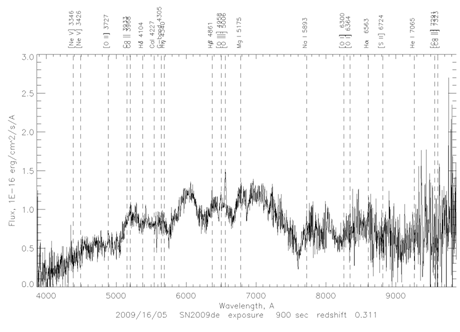
Spectrum of the supernova SN2009de with identified galactic emission lines
and estimation of red shift.
T.A.Fatkhullin, A.S.Moskvitin, V.N.Komarova, in collaboration with R.roy
(ARIES, India)
The supernova SN2008iy
Within the framework of the international program the spectral and
photometric observations of the supernova SN2009iy were fulfilled to study the
light curve, spectral evolution and to determine red shift.
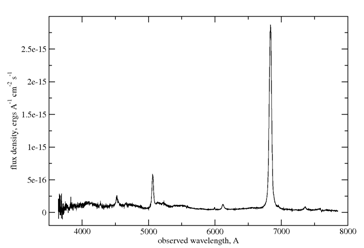
Spectrum of the supernova SN2008iy with narrow emission lines belonging to
the supernova.
T.A.Fatkhullin, A.S.Moskvitin, V.N.Komarova
Optical study of the vicinity of the pulsar PSR J0205+6449 in 3C 58
The wide-band photometrical study was made of the vicinity of the young
pulsar J0205+6449 in the supernova 3C58 remnant where an extended object was
previously detected coinciding with the pulsar in coordinates. Its morphology
and spectral properties allows us supposing that we detected an optical
counterpart of the system of the pulsar and nebula of the pulsar wind. The
publication "Optical Studies of the Vicinity of PSR J0205+6449 in 3C 58" was
prepared.
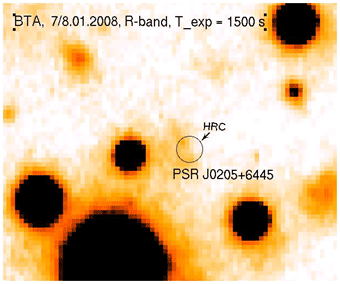
Vicinity of PSR J0205+6449 as observed with BTA in the R band. The circle
corresponds to the pulsar position from data of High Resolution Camera (HRC)
of the X-ray observatory Chandra.
V.N.Komarova in collaboration with Astro Space Center (V.G.Kurt), PhTI
(Yu.A.Shibanov, D.A.Zyuzin)
2008
Optical observation of an isolated neutron star.
In the framework of the international collaboration (Russia, Spain, Germany,
South Africa, Chile) the event SWIFT J195509+261406 was optically observed during
three days. It was discovered that this event is neither a classic gamma-ray burst,
nor a black hole in a binary system, nor a microquasar. It corresponds rather to
a model of an isolated neutron star with an anomalous magnetic field of ~1015 Gauss
(a magnetar in its active phase). A variability of optical radiation of the soft
gamma-repeater was discovered. It was shown that this event is “a bridge” in the
luminosity scale between anomalous X-ray pulsars and faint isolated neutron stars.
2007
Stellar-wind Envelope of Massive Supernova Progenitor Star XRF060218/SN2006aj.
In the early spectra of the supernova SN2006aj related to the gamma-ray burst GRB060218,
H-alpha hydrogen lines with velocities of 28000km/s and 24000km/s were found, which points to
the existence of a stellar-wind envelope in the vicinity of the progenitor star. Such envelope
is formed as a result of massive star's evolution and was observed during the burst as a
powerful thermal component in its X-ray spectrum
2006
In February 2006 the spectra of GRB 060218/SN 2006aj (z=0.033) were obtained with the BTA.
Like the case of GRB 030329/SN 2003dh (z = 0.1685), our observations turned out again among
the very first spectral observations of these two nearest GRB/SN bursts. These observational
results were obtained under a joint program of Instituto de Astrofisica de Andalucia
(Alberto J. Castro-Tirado, IAA-CSIC, Spain) and SAO RAS. In 2006, the basic result of the program
on identification of GRBs was formulated as follows: the long gamma-ray bursts are a beginning
of an explosion of distant massive SNs. The most probably, during the gamma-ray burst
we observe a relativistic collapse of a star nucleus and the birth of a very dense
compact object - a supernova explosion remnant.
On April, 8, 2005, an optical afterglow of GRB050408 was discovered with SAO telescopes (the BTA and the 1-meter Zeiss).
A variable object was first discovered by our observations in a gamma-ray burst localization area by the space observatory HETE.
The result was considered as one of the best SAO achievements in 2005.
In 1996 we managed to see stellar-like objects (R~25) with the BTA. These were the first neutron stars (NS) that we started
investigating in collaboration with the Hubble Space Telescope. We continued studying pulsar nebulae - remnants of SN bursts
(PSR B1951+32 in ÑÒÂ 80), the search and investigation of optical radiation of NSs. Fluxes for the object PSR 0656+14 and
Geminga were obtained with the BTA. The wide-band spectra of these NSs were built from UV to IR. The work is being fulfilled
in collaboration with ASC FIAN, IKI, SAI, Mexico National Institute of Astronomy.
2005
Observations
*
GRB 050408
One of the most important achievements of SAO in 2005.
*
GRB 050509b
*
GRB 050824
*
PSR 0656+14 and Geminga
Theory
*
The cosmic gamma-ray bursts lasting more than 2 seconds (long GRBs, 2-100 sec)
are now thought to be related to explosions of massive supernovae (SNe). They are idenitified in optics
with very distant (host) galaxies at cosmological distances (more than 1 GPs) with red shifts about 1
(and up to z ~10). Rusults of our investigations
(astro-ph/0506544)
were used in modelling of
energy distribution in spectra of one of such galaxies (GRB 021004, z=2.3).
A gamma-ray burst can be accompanied with an optical afterglow lasting several days in which
typical spectral and phorometric features of massive supernovae usually of types Ib or Ic are observed,
as was in the case of GRB 030329
(astro-ph/0505535).
In 2005 we studied a host galaxy of this (famous) GRB 030329 - a galaxy at z=0.17 with low metallicity
and active star formation . Spectra and spectral energy distibution were obtained
(astro-ph/0508541,
astro-ph/0507488,
a paper was accepted for publishing in A&A).
The figure shows spectral energy distribution for a host galaxy of GRB 030329 from optical to IR.
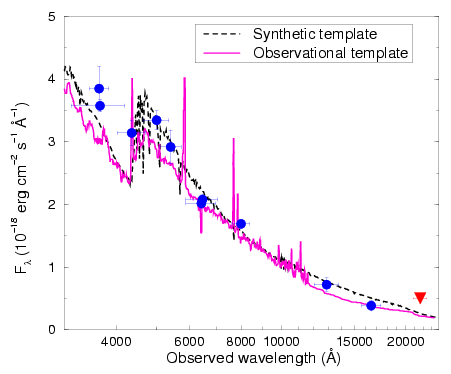
*
In 2005 we together with researchers of the Space Reasearch Institute of RAS,
Astro Space Center of RAS and Astronomical Institute of Saint-Petersburg State University
studies effects of collimation of high-energy photons and other possible observational
manifestations of angular and spectral distribution of photons in gamma-ray burst sources.
The matter is about an alternative to relativistic fireball, if all "long" GRBs are really reltated with
normal/nonpeculiar massive supernovae. Within the framework of assumptions of our model
we considered effects of radiation pressure and how jets originate due to even small asymmetry
of powerful radiation field in the burst source itself. Possible mechanisms of GRB origin
in regions of size 10{8} cm (a compact model of gamma-ray bursts) are discussed.
Observational consequencies of such "compact" energy release for GRBs are considered.
(4 communications are published and submitted for publishing. A paper was accepted
for publishing in "Astrofizika" journal.)
2004
Joint observational requests, in which an active
participation of SAO in follow-up observations with the new
specialized space platform SWIFT is supposed, are prepared
and partially realized. We observed with the BTA the optical
objects related with gamma-ray bursts: GRB040924
(observations of the optical transient in V, Rc and Ic
filters), GRB041006 (observations of the optical transient
in B, V, Rc and Ic filters), GRB041218 (the spectrum was
obtained in 6 hours after the burst), GRB041219 (the
spectrum of the transient in B, V, Rc filters was obtained
in 2 days after the burst). New data for the GRB030329 host
galaxy in V and Rc filters were obtained with the BTA.
All known results of the earliest spectroscopic and
photometrical observations of gamma-ray bursts were reviewed
and compared to all known earliest spectra of some massive
core-collapse supernovae (SN). The summarizing of our (SAO)
and other spectroscopic and photometrical data showed that
the properties of early spectra/colors of optical transients
of gamma-ray bursts and massive SNe are explained by a shock
wave moving through stellar wind generated by the pre-
supernova/pre-gamma-ray-burst. The behavior of light curves,
colors and gamma-ray burst spectra (which is very similar to
a ultra-violet jump observed for some SNe) is a result of
dense compact envelopes near massive star-progenitors of SNe
and gamma-ray bursts. The importance is emphasized of
observations of namely early SNe and gamma-ray bursts
spectra for understanding a crucial question in the physical
mechanism of gamma-ray bursts: are ALL “long” gamma-ray
bursts related indeed with massive SNe?
The analysis of results of the 6-meter telescope observations
(+ data of observations with other instruments) shows a close
relation between gamma-ray bursts and explosions of massive
stars (with formation of a compact object of type of a
neutron star) as a result of such an explosion. The basic
principles of a compact model of the gamma-ray burst source
are formulated.
2003
The earliest spectra were obtained with the BTA of an
optical transient (OT) related to the gamma-ray burst
GRB 030329. Typical broad details, which are already in these
early spectra, point to a direct relation with a supernova
(SN) burst. In the first hours the OT GRB spectrum can be
a mixture of a GBR afterglow spectrum and a early UV
spectrum of a massive Ib/c type SN. It could be a crucial
argument in favor of an idea that a cosmic gamma-ray burst
is an explosion onset of distant "massive" SNs or a collapse
of massive stellar nuclei in the end of their evolution.
In 2001-2002 the effect of OT GRB 970508 reddening in
several weeks after GRB was interpreted as an effect
confirming the relation between long-duration GRBs and the
evolution of massive stars and SN explosions, whereas
nonmonotonies in the OT GRB 970508 light curve in one-three
days could be a consequence of the following evolution
scenario for a GRB source: "a massive star --> a WR star -->
a pre-SN = a pre-GRB --> GRB and an explosion of "massive"
Ib/c type SNs".
A technique of observations with a new focal reducer
SCORPIO was developed. BVRI photometry of the GRB 000926
host galaxy (B=26.13) was carried out with the BTA. All
objects down to a BTA-record depth of B = 27.6, V = 26.8,
R = 26.8, I = 25.6 were measured photometrically in its
field of dimension of ~3 arc min. By BTA/SCORPIO BVRI fluxes
the photometric red shifts z were obtained for all objects
and the Hubble B-diagram (B value vs. z) was plotted up to
z~3.6.
Observational manifestations of different type absorption
laws in GRB galaxies were studied. The modeling of energy
distribution over their spectra was carried out;
luminosities, ages and inner absorptions were determined;
the impact of the latter on estimates of star-forming
rates or SNe rate was accounted for. A question about
"dark" (optically invisible) GRBs whose sources can be
in highly dusty regions of galaxies was studied.
A conclusion was formulated that the GRB galaxies do not
differ in their spectra from other "field" galaxies, i.e.
from normal galaxies of the same z. It means that we can
determine an average rate of GRB observations directly
from the count of these galaxies: ~5*10^{-8} GRBs per year
in the Galaxy.
2002
An interpretation of the GRB 970508 reddening effect in
several weeks after the burst (similar to 7 other GRBs with
z<1) as an effect that directly confirms the relation between
long gamma-ray bursts and the evolution of massive stars and
supernova bursts. OT GRB 970508 non-homogeneities of kind of
the second burst in one-three days after GRB can be a direct
consequence of an evolution scenario for the gamma-ray burst
source: "a massive star --> a Wolf-Rayet star --> a
pre-supernova = pre-GRB --> GRB and the supernova of Ib/c
type explosion".
Photometric red shifts for all extended objects with S/N>3
and "Hubble B diagrams" (relations between the stellar
magnitude in B filter and z) were constructed for the objects
with the red shifts about 3 in the field of the gamma-ray
burst GRB 000926 host galaxy in four (BVRI) fluxes measured
with the BTA/SCORPIO. Both the host galaxies (with
spectroscopic z) and field galaxies obey well the Hubble
general dependence for distant objects. Observational
manifestations of different types of internal extinction
laws in the gamma-ray burst host galaxies were studied. By
the results of photometric z estimations in the field of
GRB 000926 the galaxies-candidates were selected in the
spectra of which an absorption line at the wavelength of
2175\AA (the absorption line of graphite dust) can present.
A review of data on optical photometry and spectroscopy of
all gamma-ray burst host galaxies known by the end of 2002
(including spectra with continuum of GRB optical transients)
was also made. The results are presented in the form of the
Hubble R diagram.
The field of OT GRB 021004 was investigated at the BTA with
the SCORPIO device on the 29th, 30th of November and the 5th
of December. An extended object (a blue host galaxy of
gamma-ray burst with B=24.55, V=24.35, Rc=24.36, Ic=23.79)
was detected which coincides with the position of an Optical
transient (OT GRB) of this burst observed in October 2002.
2001
According to energy distribution in spectra obtained
in BTA observations, the gamma-ray burst host galaxies do not differ
from ordinary “field” galaxies of similar stellar
magnitudes and red shifts. It allows us to determine an average year
rate of gamma-ray bursts directly from observations.
2000
By data,
obtained in BTA observations, we measured the red shift
Z=0.7063 ± 0.0017 of a distant galaxy of 24th st. magn.,
in which there occurred a burst of a massive star accompanied by
the gamma-ray burst GRB 991208. The evolution of
a corresponding variable optical source was watched.
In cooperation with Space Science Institute (USA) and
Astrophysical Institute of Andalucia (Spain).
1998
During a year the program on search for host galaxies of
gamma-ray bursts has been carried out at the BTA. Blue compact sources
were discovered in the area of optical transients GRB 970508 and
GRB 980703. The identification of GRB 980519 with the
today’s most distant host galaxy was fulfilled.
1997
As a result of
BTA simultaneous 4-band observations we obtained the most detailed
light curve of an optical stellar-like source corresponding to
the gamma-ray burst of May, 8, 1997. The slope of continuous spectrum
was measured in maximum and after it. The variability of colors has
been watched up to 200 days after the gamma-ray burst.
The brightness fall rate and the color indexes were changing.
The effect of a sharp rate deceleration is noticeable in
infrared (~8000A) in 36 days after the burst. These new facts
affect essentially the modern notion of physical nature of
gamma-ray bursts. Perhaps we observe a formation of a nebula
related to the outburst in the moment of gamma-ray burst caused by
the activity of a compact object of type of a neutron star.
1996
The BVRI CCD photometry of the pulsar PSR 0656+14 was carried out
with BTA. By VLA radio source location a stellar-like object was
identified. The flux in R and I bands were first determined what
allowed us (taking into account the UV observations with HST) to speak
confidently about essentially non-thermal nature of radiation in
UV spectral optical part up to ~8000A. The optical spectrum can be
presented as a sum of non-thermal spectrum of atmosphere (surface)
of a neutron star and a non-thermal component (power-law spectrum
with the index of about -0.85).
(In cooperation with Astro-Space Center of PhIAS and
Penn State University, USA).
1994
Deep CCD images of the localization areas of bright gamma-ray
bursts GRB 790418 and GRB 790613 were first obtained. In both cases
a faint blue stellar-like object (V=24.5m, B-V < 0m) was discovered
in the gamma-ray bursts localization areas.
The observed brightness and colors allows us to suppose that it
can be objects of type of neutron stars at distance of
about 40 pc.
|

